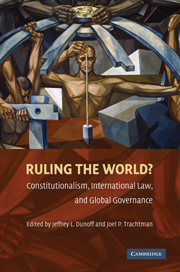Book contents
- Frontmatter
- Contents
- Contributors
- Preface: International Institutions: Why Constitutionalize?
- Acknowledgments
- PART I WHAT IS CONSTITUTIONALIZATION BEYOND THE STATE?
- PART II THE CONSTITUTIONAL DIMENSIONS OF SPECIFIC INTERNATIONAL REGIMES
- 4 The UN Charter – A Global Constitution?
- 5 Rediscovering a Forgotten Constitution: Notes on the Place of the UN Charter in the International Legal Order
- 6 Reframing EU Constitutionalism
- 7 The Politics of International Constitutions: The Curious Case of the World Trade Organization
- 8 Constitutional Economics of the World Trade Organization
- PART III CROSSCUTTING ISSUES
- Index
- References
4 - The UN Charter – A Global Constitution?
Published online by Cambridge University Press: 05 June 2012
- Frontmatter
- Contents
- Contributors
- Preface: International Institutions: Why Constitutionalize?
- Acknowledgments
- PART I WHAT IS CONSTITUTIONALIZATION BEYOND THE STATE?
- PART II THE CONSTITUTIONAL DIMENSIONS OF SPECIFIC INTERNATIONAL REGIMES
- 4 The UN Charter – A Global Constitution?
- 5 Rediscovering a Forgotten Constitution: Notes on the Place of the UN Charter in the International Legal Order
- 6 Reframing EU Constitutionalism
- 7 The Politics of International Constitutions: The Curious Case of the World Trade Organization
- 8 Constitutional Economics of the World Trade Organization
- PART III CROSSCUTTING ISSUES
- Index
- References
Summary
Is the UN Charter a constitution? Answering that question depends on what we mean by a constitution and to what alternative we are contrasting a constitution.
If the relevant contrast is to the U.S. Constitution – the constitution of a sovereign state – the answer is clearly no. The United Nations was not intended to create a world state. As the Charter's preamble announces, it was created for ambitious but specific purposes: “to save succeeding generations from the scourge of war,” to “reaffirm faith in fundamental human rights,” to “establish conditions under which justice and respect for the obligations arising from treaties and other sources of international law can be maintained,” and to “promote social progress and better standards of life in larger freedom.” The United Nations, moreover, is an organization based on the “sovereign equality of all its members” (art. 2.1), its membership being open to all “peace-loving states” (art. 4.1). This contrasts strikingly with the U.S. Constitution's much more general, sovereign-creating purposes: “to form a more perfect union, establish justice, insure domestic tranquility, provide for the common defence, promote the general welfare and secure the blessings of liberty to ourselves and our posterity.”
The UN Charter lacks at least two of the three key attributes that the Constitutional Court of South Africa identified as essential to a constitution. In Pharmaceutical, the court averred that a constitution is a unified system of law: “There is only one system of law.
- Type
- Chapter
- Information
- Ruling the World?Constitutionalism, International Law, and Global Governance, pp. 113 - 132Publisher: Cambridge University PressPrint publication year: 2009
References
- 14
- Cited by



